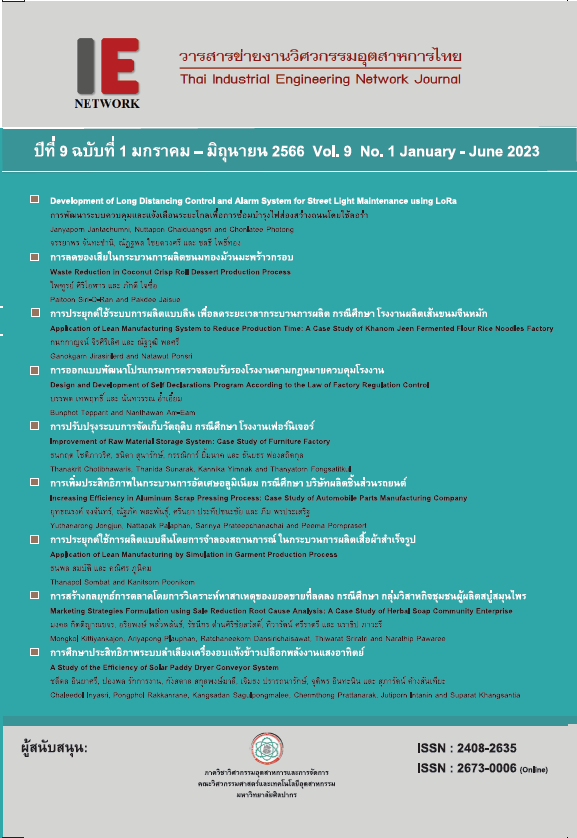Application of Lean Manufacturing by Simulation in Garment Production Process
Main Article Content
Abstract
This research aims to find ways to improve the production processing in the garment production of the factory. Case study from collecting data on problems in production by creating a value map before improvement and simulate the current situation. It was found that the printing department and the embroidery department are two departments that need to be improved urgently. The printing department produces 14.32% of waste. The embroidery department does not meet the target production of 200 units per day and the actual production capacity is 137 units per day. There are 2 wastes occurring: 1.) Wastes occurring in the printing process, such as 1.1) incomplete printing caused by a lot of dust from the factory. There is a lot of dust on the machine. Do not shake off the dust from the cloth. There is no standard practice and the fabric is not straight. Therefore, the researcher has proposed a way to improve this part by applying the 5S principle to reduce dust that affects printing and establish standard operating procedures (Work Instruction) to prevent employee error and waste in part 2.) it is the waste that occurs in the embroidery process, such as 2.1) the embroidery process takes a long time. This is due to taking a long time to prepare and placing the workpieces and parts out of order. Therefore, the researcher has applied the principles development of tools or protection against mistakes by creating a device to hold the embroidery frame. And the principles of arranging working conditions (Working conditions) appropriately by creating shelves, painting the floor and attaching various indicator signs. From the research results, it was found that improvements to reduce waste that causes waste in the printing department. Able to reduce waste that occurred from the original 14.32%. After improvement, there is only 2.87% waste. The original production capacity was 342 units per day, after improvement increased to 388 units per day, reducing production costs by 1,127 baht per day. And from improvements to reduce wastage caused by time spent on preparation work for production made in the embroidery department can reduce the preparation time and increase production efficiency with a production target of 200 units per day, which before improvement was 137 units per day, production efficiency was 68.5%, after improvement of production capacity increased to 195 units per day, production efficiency was 97.5%, production efficiency increased up to 29%.
Article Details

This work is licensed under a Creative Commons Attribution-NonCommercial-NoDerivatives 4.0 International License.
บทความ ข้อมูล เนื้อหา รูปภาพ ฯลฯ ที่ได้รับการตีพิมพ์ในวารสารฯ ถือเป็นลิขสิทธิ์ของวารสารฯ หากบุคคลหรือหน่วยงานใดต้องการนำทั้งหมดหรือส่วนหนึ่งส่วนใดไปเผยแพร่ต่อหรือเพื่อกระทำการใดๆ จะได้รับอนุญาต แต่ห้ามนำไปใช้เพื่่อประโยชน์ทางธุรกิจ และห้ามดัดแปลง
References
สำนักงานสภาพัฒนาการเศรษฐกิจและสังคมแห่งชาติสำนักนายกรัฐมนตรี, แผนพัฒนาเศรษฐกิจและสังคมแห่งชาติ ฉบับที่ 13 (พ.ศ.2566 – 2570), ข้อมูลจาก https://www.nesdc.go.th/download/Plan13/Doc/Plan13_DraftFinal.pdf (วันที่สืบค้นข้อมูล 1 พฤศจิกายน 2565)
สำนักงานส่งเสริมวิสาหกิจขนาดกลางและขนาดย่อม, การพัฒนาประสิทธิภาพและศักยภาพการดำเนินธุรกิจของผู้ประกอบการสิ่งทอและเครื่องนุ่งห่ม, ข้อมูลจาก https://www.sme. go.th/th/search.php?q=SME (วันที่สืบค้นข้อมูล 1 พฤศจิกายน 2565)
ศิรัตน์ แจ้งรักษ์สกุล, ปัจจัยที่มีผลต่ออุตสาหกรรมขนาดกลางและขนาดเล็กในการมุ่งสู่ระบบการผลิตแบบลีน, มหาวิทยาลัยธุรกิจบัณฑิตย์, ม.ป.ท., 2557
ศิ-ต รอดเครือวัลย์, LEAN ยุคใหม่สไตล์ Simple, กรุงเทพมหานคร: ปัญญาชนสำนักพิมพ์, พิมพ์ครั้งที่ 1, 2552
นุชสรา เกรียงกรกฎ, ปรีชา เกรียงกรกฎ, นิลาวรรณ ดวงใจ และปิยวรรณ คำชัย, การปรับปรุงการผลิตในขั้นตอนผลิตลวดตะแกรงวายเมท, วารสารข่ายงานวิศวกรรมอุตสาหการไทย, ปีที่ 8 ฉบับที่ 2, 2565
อุบลวรรณ อ้นโต, การประยุกต์ใช้ระบบการผลิตแบบลีนและผังคุณค่าโดยการจำลองสถานการณ์ในการผลิตยางรถยนต์, จุฬาลงกรณ์มหาวิทยาลัย, ม.ป.ท., 2552
ยุทธณรงค์ จงจันทร์, เมธี พรมศิลา, เษกสรร สิงห์ธนู และภีม พรประเสริฐ, การปรับปรุงกระบวนการประกอบชุดจับยึดที่นั่งของรถยนต์โดยใช้หลักการสมดุลสายการผลิต, วารสารข่ายงานวิศวกรรมอุตสาหการไทย, ปีที่ 3 ฉบับที่ 2, 2560
อติชา วัชรานุรักษ์, การประยุกต์ใช้ระบบลีนในกระบวนการผลิตเสื้อผ้าสำเร็จรูป กรณีศึกษา การผลิตเสื้อโปโลเชิ๊ต, วิทยานิพนธ์ปริญญามหาบัณฑิต, มหาวิทยาลัยเทคโนโลยีราชมงคลธัญบุรี คณะวิศวกรรมศาสตร์ สาขาวิชาวิศวกรรมสิ่งทอ, 2552
ประจวบ กล่อมจิตร, เทคนิคการเพิ่มผลผลิตในองค์กร หลักการและตัวอย่างการปฏิบัติ, สำนักพิมพ์ซีเอ็ดยูเคชั่น, 2557


